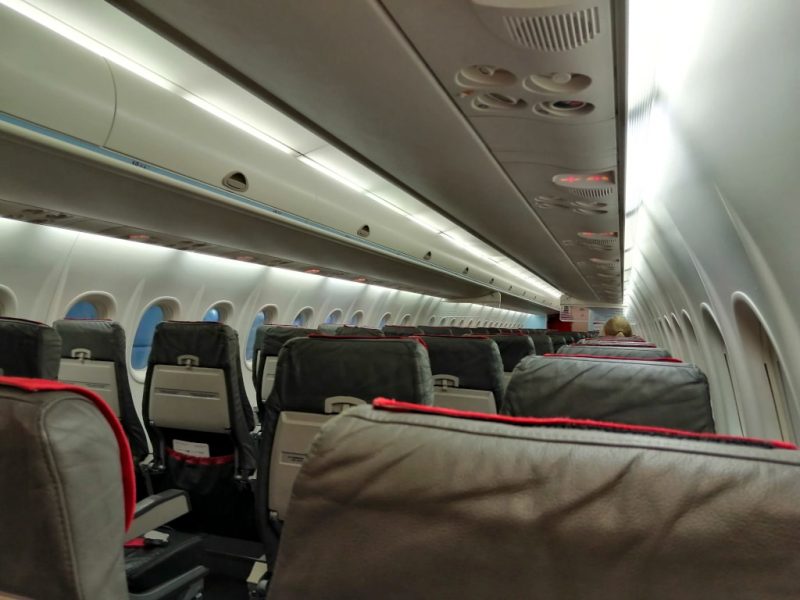Much has changed in the travel industry since air traffic was largely resumed around mid-June 2020. Unfortunately not exactly positive, because passengers and transport companies are still confronted with a patchwork of different entry and quarantine regulations. Germany in particular is currently showering all of Europe with travel warnings and is defining one country after another as a so-called “risk area”.
For a short time from June or July 2020, at least within the Schengen region, there were hardly any noteworthy entry requirements, because the states and the European Union initially sought to restore largely normalcy. The flight load factor was still quite weak in June, but there were also positive outliers. For example, a flight from Vienna to Stuttgart operated by Eurowings on June 19, 2020 had just over 30 passengers on board, but a few days later the return flight was completely full.
Malta opened to many states on July 1, 2020 and only required two forms to be filled out. The few sandy beaches of the island state have probably not been as empty as they were this year, but the utilization of the flights initially developed positively. In July 2020 there was still a lot of space in the planes of Wizzair, Lauda / Ryanair / Malta Air, but in August 2020 they were mostly full. In spontaneous conversations, many passengers said that because of the low price, they spontaneously went for one Holidays in Malta and / or Gozo decided. That changed suddenly in September and October 2020, because the classic vacation time was over and thus the planes of the Ryanair Group and Wizzair became noticeably emptier flight after flight. The proverbial “rest” was obviously the decision of the Maltese government that Austria landed on the “Amber List”. A negative PCR test must be presented. The consequence of this is that Wizzair suspends the Vienna-Luqa route over the winter, Air Malta has reduced the frequencies and the Ryanair Group is temporarily hiring.
A similar picture emerges on the routes to Athens and Thessaloniki, although the last-mentioned airport is currently not accessible for official reasons. Greece really boomed in the summer, but since the end of the summer holidays there has been a noticeable decline in demand. The occupancy fluctuated extremely strongly in September and October, so there was almost everything between about 10 passengers and fully occupied. Nevertheless: Almost all airlines that are active in Austria-Greece traffic have severely cut their offers and have put some destinations on an early "winter break".
Low-cost airlines such as Ryanair and Wizzair continue to use their “trump card” with ultra-cheap tickets. In normal times, the machines could be filled with it and if the passenger buys something extra or falls into paid rip-offs, you could even earn money with it. But this concept no longer works. For example, on the day of departure on the Vienna-Modlin route, tickets were still offered for 7,99 euros, but there were only 22 passengers on board. Conversely, Warsaw-Vienna was also blessed with Wizzair with particularly cheap tickets, but the A321neo mostly flew empty seats. There were only 33 passengers on board. The consequences of this: Wizzair is temporarily suspending Warsaw-Chopin and the Ryanair Group at least severely shortened Modlin.
The Italian routes to Bergamo and Malpensa ran well well into October 2020. The main customer group, however, was predominantly Italians who took advantage of the offer. Rome and other Italian routes didn't go as well after the end of the summer holidays, but they did much better than other destinations. In any case, the low-cost airlines were able to achieve very good occupancy rates on the Lombardy flights until recently. That is the end of it now, because the demand has collapsed on both sides. It remains to be seen whether and for how long the providers will continue to operate these routes.
An interesting picture emerged in the past two weeks on the flights to / from Borispil and Kiev (Shulyany). At first, the occupancy rate at Wizzair was very high, only a few seats remained empty. But the picture changed only a week later: Lauda Europe flew with 80 passengers on the A320 from Vienna to Borispil and Wizzair on the same day with the same type of aircraft with 62 passengers from Kiev-Schuljany to Vienna. Both sides are the Entry comparatively simple, but the advance booking figures are obviously very bad. Both carriers are temporarily suspending their Kiev connections.
Things are hardly going any better at Austrian Airlines, but the effects of being classified as a “risk area” are clearly visible in traffic in Germany. On the Vienna-Stuttgart route, the load factor was much lower than at Eurowings even in the summer, even though the AUA sometimes offered the tickets more cheaply than the sister company in the group. The DHC Dash 8-400 machine type is predominantly used, but the turboprop aircraft are rarely more than half full. On a flight carried out with an Airbus A319, there were only 18 travelers in the medium-haul jet. Since Germany first classified Vienna and later the whole of Austria as a so-called “risk area”, demand has really plummeted. With a few exceptions Eurowings temporarily operates the Austria-Germany routes. Austrian Airlines initially cut the service significantly and is increasingly using the Dash 8-400 on the remaining frequencies. With Leipzig and Nuremberg two Germany destinations disappear from the flight plan.
Recently, short-term cancellations have been increasing at Austrian Airlines, although in at least two cases it was not considered necessary to inform the passenger about them. The consequence of this is that the AUA incurs avoidable costs by selling as many frequencies as possible but cutting them short-term. The claims from EU Regulation 261/2004 are not invalid, so the carrier has to pay if the cancellation is less than 14 days before departure. The time at which the passenger is informed of this is decisive. And that is exactly what is not working smoothly at the moment, as one of the airline's employees admitted. Because of the many deletions, you simply can't keep up. Incidentally, Klagenfurt will be discontinued.
The load factor on the Vienna-Stuttgart route fluctuated from September 2020 onwards. In September 2020 the machines were still about half full, in October 2020 the load factor dropped significantly and more flights were canceled or frequencies were taken out of production. While there were around 2020 passengers on a Graz-Stuttgart flight in October 12, only two passengers flew on this route last Friday. The return flight had ten travelers on board. A Dash 8-400 was used. The feeder from Vienna to Graz was also underutilized with only 13 passengers.
Unfortunately, these are no longer isolated cases, because on October 30, 2020 there were also fewer than 25 passengers on the Embraer 195 on Vienna-Munich. But it was even more intense in Germany at Lufthansa: a mere 12 passengers in the Airbus A320neo to Berlin-Tegel. Easyjet was on the two days later First flight from Berlin-Brandenburg to Vienna with 49 passengers in the A320neo also very weakly occupied.
Of course, all of the information given on the occupancy rate of the respective flights are only subjective snapshots. Every connection is different, but unfortunately a trend can be recognized: There are fewer and fewer passengers and the demand is falling even further. Politicians are not providing any support here either, because rapid tests are still not recognized as a substitute for PCR results and / or quarantine. It is likely to be an ice-cold winter in Germany, because on the one hand the government stigmatizes travel and on the other hand the new ones lead entry requirements taking into account the fact that the Federal Republic of Germany is gradually classifying almost all of Europe as a “risk area”, this leads to a further slump in demand. The final question that is posed in the room is therefore entirely justified: How long will the industry hold out or when will the first carriers have to discontinue their flight operations again?
Recommended reading:
On Aviation.Direct Instagram page numerous photos and videos have been posted that show the current low occupancy rate.







 trail (for them it's free to use)
trail (for them it's free to use)
Comment